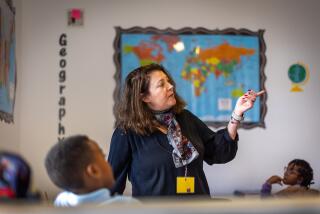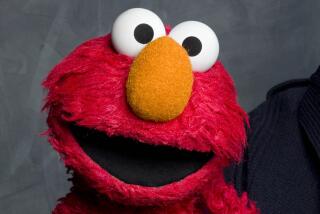‘Sesame Street’ : Research, Not Ratings, Sets the Tone
NEW YORK — It begins one morning in a preschool in Harlem, this whimsical television experiment called “Sesame Street.”
Skipping quickly to the center of a large classroom, half a dozen 4-year-olds settle quietly into two rows of miniature chairs. Their faces fixed on the good-sized television screen in front of them, they watch carefully for a moment or two. Then, paired with an adult, they begin to chatter, trying their best to explain what it is they’ve just seen.
With each word they utter and with every wiggle and squirm, the pint-sized “focus group” gives the adults, all of them researchers, what they need to know.
Scholarly papers will flow from the morning’s work and from other mornings like it. Not by accident, so will the foundation of next season’s “Sesame Street.”
A Breed Apart
It is this work in preschools and day-care centers that marks the beginning of a marathon effort that ends finally with the airing of 130 “Sesame Street” episodes each year on virtually every public television station in the nation. And it is this painstaking, behind-the-scenes research by “Sesame Street” staffers in New York’s poorest neighborhoods that has set the program apart from other television shows of its kind for the last 20 years.
“Sesame Street” has been held up as a major force in preparing preschoolers for formal education. Some educators even call the show a kind of video version of the Head Start Program--which helps “have-nots” of the preschool world catch up with “haves” by mastering simple word and counting skills and by learning basic social mores.
“There’s no other children’s program that comes close in matching its success in a number of dimensions,” proclaimed Daniel R. Anderson, a University of Massachusetts psychologist who specializes in children’s viewing habits. “The show is constantly being revised on the basis of research findings. It’s unique in the amount of research . . . unique in its following and its acceptance.”
Nearly every preschooler at one time or another sees the program. So do most of their parents.
Research and reputation aside, however, the show is not without its critics.
Despite all the hoopla that accompanies Big Bird--the inquisitive, yellow-plumed centerpiece of the program--and his pals, the last thorough look at “Sesame Street” as an educational tool was in 1971. That survey by the New Jersey-based Educational Testing Service showed, among other things, that viewers did learn elementary number, letter and problem-solving techniques and that those who viewed most, learned most.
Judgments ever since have been based more on seemingly endless anecdotes than hard facts.
They come from a kindergarten teacher in West Covina who started surveying her students years ago after they suddenly, and inexplicably, seemed smarter. Nearly all watched “Sesame Street” daily, “sometimes twice a day if they could,” Beverly Claxton concluded.
They come from a Los Angeles woman who swears that her granddaughter was barely 15 months old when she toddled over to a plaque of her name and began to spell it. “I had witnesses . . . it was amazing, “ Millie Bettinger boasted. “She learned that from ‘Sesame Street.’ ”
And they come from a veteran inner-city teacher who credits “Sesame Street” for helping to revolutionize instruction in the early grades. First-graders who could not have written their names 20 years ago, “are now being taught to read in most kindergartens,” Los Angeles teacher Melba Knutsen noted. “It’s no miracle.” But the sweep of testimonials, however favorable, has not been enough to quiet the steady trickle of criticism that has dogged the program since its beginning. Various doubters blame “Sesame Street”--a briskly moving melange of 30 or 35 segments an hour--for shortening attention span, for raising false expectations about school, for pushing kids too early and for solidifying, even stretching the gap between the poor and middle class.
Other Choices
In place of “Sesame Street” and its main competitors--those noisy, action-packed cartoons that dominate network programming for children--the critics would have young viewers turn to the gentler, slow-moving Mr. Rogers or even the Ben Vereen-hosted “Zoobilee Zoo,” an equally fanciful show in which the stars are humans, each playing an animal.
“It’s awkward of me to be talking this way . . . it’s like attacking motherhood or religion or something,” said Jerome Singer, a Yale University psychologist. “The kids who watch (“Sesame Street”) are having some fun maybe but that’s about all. . . . There’s a difference between enjoying something and learning from it.”
Although he gives the show “a B to a B plus,” Harvard University psychiatry professor Alvin Pouissant, a consultant to television’s “The Cosby Show,” said he fears that the gains youngsters make quickly evaporate once they start school.
“Can you say it’s made a major difference in the inner-city and (school) dropout rates?” Pouissant asked. “They are even higher than they used to be. . . . If “Sesame Street” gives kids the expectation that education is always entertaining, then you may have a problem.
“Teachers are not up there singing, clapping and being engaging with quick changes of images.”
To set the record straight, skeptics and supporters alike have clamored for something definitive.
University Study
In answer, the Children’s Television Workshop, the not-for-profit corporation that produces “Sesame Street” and its newer television siblings, recently ordered the University of Kansas to take a hard look at the show and its impact on schooling. Although completing that $1.2-million study will take seven years, CTW President David Britt already is predicting that the news will be good.
“I would be very surprised if the research didn’t show that those kids who watch the show fairly frequently, those kids who get any kind of support from . . . parents or day-care centers . . . learn more and are better prepared for school,” said Britt, a scholarly looking man who works from behind a desk that is custom-made to display his collection of stuffed Muppets. “If this program isn’t fundamentally educational, there’s no point in doing it.”
No such proof is needed when it comes to entertainment.
The magical blend of animation, puppetry, music and heart-tugging theatrics that is “Sesame Street” has captivated millions of Americans and audiences in 84 countries around the world.
Earlier this year, the program culminated its second decade of production by taping episode No. 2,615 in its Manhattan studio, an astounding accomplishment in the fickle world of television. At last tally, it was drawing an estimated 11 million viewers a week, at least half of them finicky 2- to 5-year-olds.
“Not only do virtually 100% of kids watch ‘Sesame Street’ . . . but 80% of the time spent viewing children’s educational television is ‘Sesame Street,’ ” said John C. Wright, co-director of the University of Kansas Center for Research on the Influences of Television on Children.
More than anything else, what draws children into becoming “Sesame Street” addicts--some are known to watch two and three hours a day--is that collection of sweet, cranky, curious, colorful characters called Muppets. Along with the humans who live with them in and about the weathered brownstone at 123 Sesame Street, the puppets, with all their idiosyncrasies, give the program its fanciful flavor.
“ ‘Sesame Street’ has been able to build a cast of characters that were not only instructional but characters that became kind of role models, very significant persons to the young child,” said Gordon Berry, a UCLA psychologist who studies media and social behavior.
From curmudgeonly Bert and bubbly Ernie, the odd couple of the Muppet ensemble, children learn that differences are OK, that opposites can complement. Bert wants to sleep at night, Ernie likes to sing. The two get along.
From the purple-faced puppet Count Von Count, his speech Transylvannian-tinged, they learn about numbers. Von Count, despite his biting wit, doesn’t want to suck blood. He only “vahnts” to count . . . 1s, 2s and 3s.
And from newlyweds Maria and Luis, the Latino couple who run the neighborhood fix-it shop, children learn about love and marriage. Along with the birth of their baby, later this spring, will come other lessons as well, these about sharing, parenting and responsibility.
Because childhood educators believe preschoolers learn more when they watch with someone else, the program also tries to woo parents and older brothers and sisters. Each hourlong episode is chockablock with plays on words, parody and other brands of humor to draw the more sophisticated audience.
“The only rule we’ve always made on that (is) if a child senses that he’s being deprived of something because it’s over his head,” explained director Jon Stone, a white-bearded bear of a man who has been with the show since its start. “Then we try to draw the line.”
Innocent Spoofs
And so, “Sesame Street” features “Dreams of Our Lives,” a play on the long-running television soap opera “Days of Our Lives.” It has two rock ‘n’ rolling Muppets performing “Born to Add,” a musical segment that sounds suspiciously like Bruce Springsteen’s “Born to Run.”
And there is “Monsterpiece Theatre,” a clever parody of public television’s prestigious “Masterpiece Theatre” with its urbane host, Alistair Cooke. On the “Sesame Street” version, a goo-goo-eyed Cookie Monster mimics Cooke by using the name Alistair Cookie.
From his book-lined study, Cookie introduces his version of Alfred Hitchcock’s classic film “39 Steps”--where Grover, another of the Muppets, climbs 39 steps, only to find a brick wall at the top. Grover slides down a banister and crashes through a wall at the end to land on Cookie’s lap.
“The perfect bit has to teach something, it has to have a gag at the end, it has to be funny and it has to be on two levels so that a grown-up will watch it,” explained Sonia Manzano, who has played Maria since the third season. Now in her late 30s, Manzano moonlights as one of the show’s 15 writers.
The upcoming birth of her television baby and her fictionalized wedding last season to Luis has given Manzano a dominant role on “Sesame Street.” Portraying love, marriage and birth on a program for tots too young to read also has given writers and researchers one of their biggest headaches.
“We were breaking new ground,” explained head writer Norman Stiles, who, like most of his fellow scribes, came to ‘Sesame Street’ from the world of adult comedy.
“There was no research, there were no books out there on that whole subject. One of the things we don’t want to be doing is just going on our own instinct. . . . And so they (‘Sesame Street’ researchers) did a lot of fancy footwork to try to get some information for us.”
Research director Valeria Lovelace launched her own study, using the local day-care centers as testing sites.
“We had to figure out how preschoolers interpret a loving relationship between a man and a woman,” explained Lovelace, a social psychologist specializing in childhood education and herself the mother of three young sons.
The 25-page position paper she produced--aptly titled “First Comes Love, Then Comes Marriage, Then Comes Maria and Luis with a Baby Carriage”--identified symbols that preschoolers associate with love. Kissing, hugging and picking flowers ranked high.
On childbirth, the testing revealed that youngsters had a “fascination with everything about the baby, listening to the heartbeat, that kind of thing,” Lovelace said. But they had little understanding of pregnancy.
Subject of Birth
Scripts were fashioned to have Maria tell a curious Big Bird that creating a child “was a deliberate thing that people did, grown people did,” Manzano said. “We said Luis and Maria got together and decided to start a baby inside Maria and . . . and so they started the baby growing.” On May 12, the birth will close out the 20th season.
For Lovelace, work already has begun on the 21st season. As she sees it, the idea is always to make the show’s “next year better than its last.”
She targets what tots can be taught and the best way to teach them, and passes that on to the program’s creators. She pinpoints the episodes that don’t work and the ones that do and she figures out why. In terms of the show’s production-heavy $14-million annual budget, the process is a bargain, costing only $350,000.
Since last fall, she and her three researchers have been testing possibilities for next season, including lessons on geography and ecology. The results so far are promising.
One 3-year-old made believers out of the researchers by defining a mountain as “the woods going uphill.” He could point out Africa on a globe and knew maps were useful because “you could find out where you belong” on them, Lovelace said.
The researchers now knew geography could be taught to preschoolers. They only had to figure out how.
So they traveled one morning to Harlem’s Charma Day Care Center. A dozen children would be studied that day and for each group of six, the routine was the same. For a few minutes, the youngsters would watch test segments on a TV monitor and then be individually interviewed.
Played Reporters
To begin the “game,” researcher Pimon Reutraual asked the boys and girls to play reporter and remember what they were about to see.
Two other researchers noted if each child was watching the videotape. For a segment to be called a success, at least 70% of the children must watch it and 51% understand it.
The researchers jotted down other observations. Were the little ones tapping their toes, clapping their hands? Were they fidgeting, were they singing along? Such tidbits could tell the writers which skits were winners and which ones bombed.
One test segment featured a travelogue on a desert, a word that most preschoolers don’t know. A voice off screen defined the desert as earth that is hot and dry. He explained how it is home to birds and prickly plants called cactus.
Four-year-old Terrence remembered it all.
“This was a desert,” Terrence told Lovelace, “Nobody lives there but birds. . . . It’s hot and it rains very little.”
Ponytailed Tamaira was more typical. All she managed to tell researcher Marguerita Perez was that the land--she can’t remember what it was called--is cold.
The little girl did better later, after seeing scenes of a roiling ocean, a rushing river, a tropical island and a towering mountain. After telling Perez the island was “ground,” the ocean “water,” the talkative little girl impishly handed them a bonus. “If sharks are in the water, you could die,” Tamaira said knowingly. “Sharks can bite you but fishes can’t bite you because they have little mouths.”
Later, the researchers retreated to their CTW offices on Manhattan’s upper West Side, where they spent the afternoon comparing notes, compiling data and etching out some rudimentary conclusions.
“It’s exciting,” Lovelace said of the morning’s work. “If we can teach the children letters and numbers, we can teach them shapes of continents and states and countries. The kind of research we’re doing now is exploratory, but in my mind, it’s saying it’s possible.”
Some Skirmishes
Whenever Lovelace’s view of what’s possible clashes with that of head writer Stiles, executive producer Dulcy Singer referees. The skirmishes do happen.
Not surprisingly, Lovelace sees education as the program’s reason for being. To Stiles, “it’s entertainment” first, then educational.
“You’re not going to teach them anything,” he explained, “if they’re not watching the set. . . . Because (the researchers) have a particular point of view that is different from our point of view, we do have our battles.”
Most of the time, the differences are worked out amicably. Lovelace objects to a script having Oscar the Grouch cavort through the show with a bag over his head “because it is dangerous.” The segment is scratched.
She objects to a segment featuring a smoke-blowing dragon because “we don’t want to encourage any kind of smoking.” The segment is aired but the dragon blows bubbles.
“Most of the time, they can work out a compromise or one or the other will win the other over,” said Singer, who has spent 20 years with “Sesame Street.” “It seems to me that most of the time . . . it strengthens the show.”
In a West Los Angeles preschool where most of the youngsters come from poor, Spanish-speaking and Middle Eastern-born families, “Sesame Street” is so much a part of life that few see it as special.
Most of the 3- to 5-year-olds watch the program at home regularly, so when teacher Jewel Charlot flips it on in a classroom, all but a few wander away to play house or scribble stick figures. They already have seen Oscar the Grouch lurching out of his trash can and the lesson on the numeral 9.
Later, when they play a counting game, identifying 9 is no problem. Neither is reciting the alphabet nor arranging the letters into words.
“I can spell my name,” offers 4-year-old Desiree. “D . . . e . . . s . . . i--you have to dot the i--then r . . . e . . . e. . . . It’s easy.”
More to Read
Sign up for Essential California
The most important California stories and recommendations in your inbox every morning.
You may occasionally receive promotional content from the Los Angeles Times.










